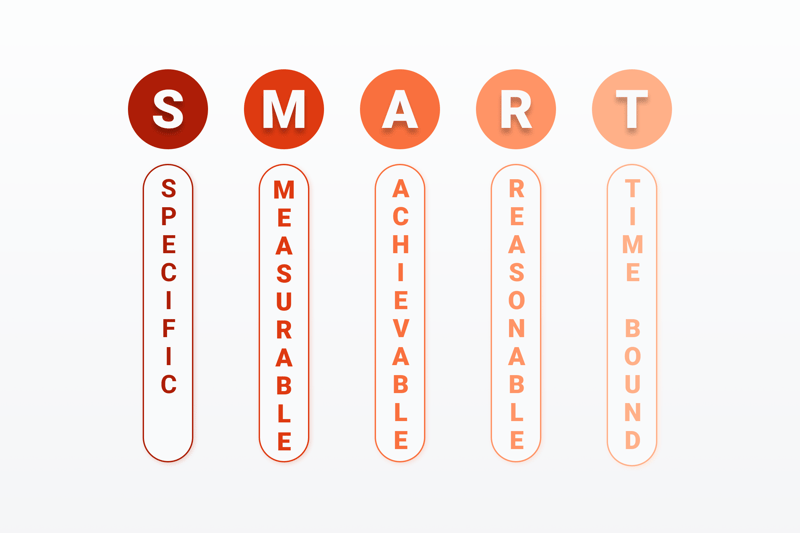We set goals in our personal and work lives. At the end of the day, a goal is nothing more than an ideal condition that we'd like to achieve at some point in the future. Despite this, goals are often missed, but why?
Sometimes, there's a lack of motivation, while for others, the target isn't specific enough. As such, to reach a goal, you need to make sure that it's clearly formulated. One popular way to do this is with the SMART formula. In this article, we'll introduce you to this approach and let you know how it can help you clearly formulate goals.
What Is the SMART Formula?
SMART is a formula that can help users to formulate precise goals. The acronym first appeared in 1981, in an economics article written by Georg T. Doran and is based on a concept developed by Peter Drucker. The SMART method makes goals tangible and attainable.
The acronym stands for:

There are five characteristics of SMART goals.
S – Specific
M – Measurable
A – Achievable
R – Realistic
T – Time Bound
Below, we'll take a closer look at what's meant by each of these five characteristics:
for Specific
Users should formulate goals are specifically and precisely as possible. The questions below can help to firm up goals and make them more descriptive.
Who?
Who is involved with the project or goal, and what is their role?What?
What should the project achieve? What should the results look like at the end?Where?
Is there a location associated with the goal? Where will the results be visible?Why?
Why is the goal being pursued? What is its purpose?Which?
Which foreseeable obstacles or difficulties are there?
Not every question above will apply to each SMART goal. For example, "Where?" might not have any relevance to your target. All the same, it's recommended to consider all of the questions and integrate the answers into your goal-setting. The answers to "Why?", in particular, can provide a great deal of motivation.
The objective isn't to precisely determine how to reach a certain goal, but rather, to approach and describe the goal from a handful of different perspectives. After a goal has been set, you can start to work towards its achievement.
for Measurable
Once you've determined what your goal is, you'll want to measure it. When is the goal considered achieved, done, or reached? Stats, numbers, and figures can help quantify this.
If the goal is "Increase new customer acquisition", it won't be possible to measure its achievement. For this reason, it's important to provide concrete numbers. A better goal similar to the above would be "Increase new customer acquisition by 10%".
When the goal becomes measurable, the project's success can be clearly determined. This also keeps goals firm and prevents them from changing over time, which can happen with a more loosely formulated target.
for Achievable
The more achievable a goal, the more motivated team members will be to reach it. Anyone who works towards it will readily see their efforts' purpose, meaning, and importance.
Acceptance of a goal also plays a role here: When a target has been set, the purpose of which is unclear or disputed, it will likely encounter resistance. To boost acceptance, involve those who will work towards the goal in the previous steps.
for Realistic
A goal is realistic when it's achievable. Think big and have a vision, but make sure that your feet are on the ground. Unrealistic goals sap morale and decrease motivation and acceptance. Would you want to work on a project whose success you're not confident in?
At the same time, a goal that is challenging, but realistic, can boost your team's motivation.
for Time Bound
The final characteristic of a SMART goal is its relation to time. When will the result be ready? If this isn't known, the project doesn't have a framework. However, once a target date or period is set, the team can work on milestones that will indicate the project's progress.
Formulate SMART Goals
SMART goals are those formulated based on the above characteristics. But what do these look like in practice?
Criteria in Practice
A goal is considered SMART when it fulfills all five of the criteria above, namely, that it's specific, measurable, achievable, realistic, and time bound.
For some goals, however, it's either not possible or desirable for all of the above criteria to be applied. As a result, users of this technique should carefully consider whether each characteristic is relevant and necessary for their goal.
Issues and contradictions can also arise between realistic and achievable: An ambitious goal is generally preferred to a less ambitious one. However, as the level of difficulty and complexity increases, targets become less achievable. Try to maintain a balance between these two factors as it will give your goals a better chance of success.
Not every criterion needs to be explicitly referenced when you formulate a goal. It's not uncommon for a goal to have a catchy title, with more detailed questions addressed in the goal's description.
Ensure High Chances of Success
In addition to the SMART formula, you can also try out the tips below to increase the likelihood of your targets being reached:
Is the goal a long-term one? If so, milestones can help to achieve it and keep motivation high.
Write down your goals and display them in an area where all participants can see them. As the saying goes "Out of sight, out of mind."
Use a graphic to help visualize and internalize goals.
Formulate goals in the first person, to make it easier to identify with them.
Make sure that your team is committed to the goals that they work on. Participants can sign their names under the goals.
Check at regular intervals how much progress has been made towards goals.
Examples
We've discussed the theory, now it's time for some examples:
Example 1 – Continuing Professional Development
Poor Goal | Better Goal | Explanation: |
|---|---|---|
I want to continue my professional development. | I will finish my business degree at the end of this year with a B average. | The first goal is formulated too loosely: What does the individual study or train toward? The second goal is much more specific (course of study), time bound (end of the year), and measurable (B average). In addition, the average grade is achievable and realistic, but potentially, also a challenge. |
Example 2 – Sport
Poor Goal | Better Goal | Explanation |
|---|---|---|
I want to exercise more. | I will jog 10 miles per week. | The first goal isn't clear about what's to be achieved. This is readily identifiable in the second goal, however. The individual will run 10 miles (specific and measurable) every week (time bound). Once again, the goal is a challenge, but realistic, even for beginners. |
Example 3 – Customer Satisfaction
Poor Goal | Better Goal | Explanation |
|---|---|---|
We will improve customer satisfaction. | We will improve our customer service department's customer satisfaction rate by 10% by the end of the year. | While the first goal is good in terms of what's to be achieved, the second goal specifies this further (customer service department), time bound (end of the year), and is measurable (by 10%). The second goal is a SMART goal. |
Advantages and Disadvantages of SMART
There are advantages and disadvantages to use of the SMART formula, such as:
Easily and clearly structure complex ideas.
Can be used at both work and in your private life.
Project managers are able to see how feasible a goal is.
SMART goals motivate those who work on them and firm up tasks and assignments.
Users might stick too rigidly to categories, which makes goals harder to achieve.
Goals can also be looser than the formula calls for. When certain criteria are deliberately overlooked, the goal's specification and achieveability can suffer.
Doesn't take all decisive factors into account.
Visions that are too far in the future and not time bound cannot be translated into goals.
Alternatives to the SMART Method
SMART is the most well-known, but far from the only method that's available to help set and formulate goals.
There are even extensions to the formula, such as SMARTER. The extra letters stand for "evaluated" and "reviewed". And then there's the PURE model (positively stated – understood – relevant - ethical).
Conclusion
Far too many goals are never achieved because they're either not firm enough, or improperly stated. The SMART formula can help to improve both aspects. When you apply its five criteria, your goals will be specific, measurable, achievable, realistic, and time-bound.
SMART's biggest advantage is its ease of use. Whether for work goals or personal ones, you can use the formula to set and achieve targets. Just keep in mind that not all of the five factors are relevant or applicable to every goal. It also isn't advisable to stick too rigidly to the formula after you've started to work towards your goal.












